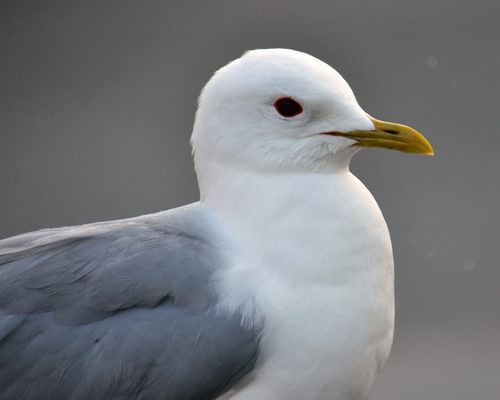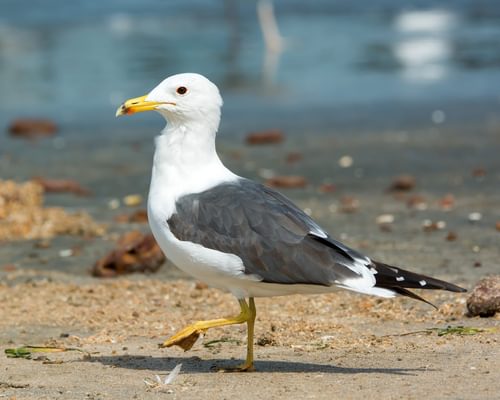European Herring Gull
Least ConcernLarus argentatus
Visual Identification
Appearance
The Herring Gull is a large, robust seabird with a distinctive white head and body, contrasting with light grey wings and black wingtips. Its yellow bill features a red spot near the tip, and it has pink legs.
Non-breeding birds have grey-brown streaks on the head and neck. Juveniles display mottled brown feathers, gradually transitioning to adult plumage over four years. Both sexes look alike, with males slightly larger on average.
Size
Length
55cm to 67cm
Wingspan
130cm to 158cm
Weight
800g to 1.25kg
Colours
Males and females have similar plumage
Primary Colour
White Grey
Secondary Colour
Black
Beak Colour
Yellow
Leg Colour
Pink
Habitat and Distribution
Habitats
Woodland
Garden
Wetland
Coastal
Urban
Farmland
Grassland
Desert
Tundra
Rainforest
Mountain
Savanna
Distribution
Herring Gulls are primarily coastal birds found along the shorelines of Europe and parts of Asia. They frequent rocky coasts, beaches, and offshore islands during the breeding season.
In winter, many birds move inland or further south. They are common in the UK and are often seen in coastal cities and towns, as well as around large lakes and reservoirs.
Elevation Range
Sea level to 2,000 meters
Climate zones
Temperate, Subarctic
Distribution Map
This map gives you a rough idea of where you might spot a European Herring Gull. The coloured areas show countries where these birds have been seen.
A few things to keep in mind:
- Birds might not be everywhere in the coloured areas, for example, they may be present around the coast of that country
- Where birds live can change with seasons and available food
- This map is quite simple - it doesn't show exact locations
We're working on making our maps even better! Soon, we hope to show you:
- More detailed maps for bigger countries, including state and region
- How birds move around during different seasons
Distribution by Region
Behaviour and Ecology
Bird Attributes
This feature is in beta. We'd love your feedback to improve it!
Share your thoughtsBird Attributes Explained
Our bird attributes system rates various aspects of a bird's capabilities on a scale of 0-100, based on data from field observations, scientific studies, and expert knowledge.
Attribute Categories:
- Agility: Manoeuvrability, speed, and grace in flight or movement.
- Strength: Physical power, often correlating with size and hunting abilities.
- Adaptability: Ability to thrive in various environments or changing conditions.
- Aggressiveness: Territorial behaviour and assertiveness, particularly during breeding seasons.
- Endurance: Stamina, often seen in migration patterns or foraging behaviours.
Understanding the Ratings:
- 0-20: Very Low
- 21-40: Low
- 41-60: Average
- 61-80: High
- 81-100: Very High
Remember, these attributes are relative to other bird species and don't necessarily indicate superiority.
Hover over the icon next to each attribute for more information.
Tap the icon next to each attribute for more information.
Agility
Reflects the bird's manoeuvrability, speed, and grace in flight or movement.
Herring Gulls display remarkable agility in flight, adeptly manoeuvring through coastal winds and urban environments. Their ability to snatch food mid-air and perform complex aerial courtship displays demonstrates their high level of aerial prowess.
Strength
Indicates the bird's physical power, often correlating with size and hunting abilities.
As large seabirds, Herring Gulls possess considerable strength for their size. They can carry substantial prey items and withstand harsh coastal conditions. Their robust build allows them to dominate smaller birds at feeding sites.
Adaptability
Represents the bird's ability to thrive in various environments or changing conditions.
Herring Gulls are exceptionally adaptable, thriving in diverse habitats from remote coastlines to bustling cities. Their varied diet, including the ability to exploit human food sources, and their capacity to nest in various locations showcase their remarkable adaptability.
Aggressiveness
Measures the bird's territorial behaviour and assertiveness, particularly during breeding seasons.
These gulls exhibit high levels of aggression, particularly during breeding season and when competing for food. They're known to fiercely defend their nests and young, and their boldness in urban settings further demonstrates their aggressive tendencies.
Endurance
Reflects the bird's stamina, often seen in migration patterns or foraging behaviours.
Herring Gulls demonstrate impressive endurance, capable of long-distance flights and surviving in harsh coastal environments. Their ability to live for over 30 years in the wild, with some individuals reaching nearly 50 years, is a testament to their physical resilience and endurance.
Diet
Herring Gulls have a varied diet, including fish, marine invertebrates, and carrion. They also steal food from other birds and are skilled scavengers, often seen foraging in urban areas for human food waste.
Their ability to exploit diverse food sources, from mussels to chips, contributes to their adaptability and widespread distribution. Discarded food and scraps around towns and landfills are essential food sources in many areas.
Behaviour
Herring Gulls are opportunistic and adaptable birds. They often follow fishing boats, looking for discarded fish, and have learned to drop hard-shelled molluscs onto rocks to break them open. These gulls are social, often seen in large, noisy flocks, especially during breeding season or at rich food sources.
Vocalisation
Herring Gulls are known for their loud, raucous calls. Their most recognisable vocalisation is a piercing 'kyow' or 'kee-ow', often described as a laughing sound. They also produce a variety of other calls, including a rapid 'kuk-kuk-kuk' when alarmed or a soft mewing during courtship.
They utter their characteristic screaming ‘long call’ when approached by other gulls near their nest or when feeding. This call serves an aggressive territorial function.
Nesting & Breeding
Herring Gulls typically breed in large, noisy colonies. Pair formation begins in spring, with elaborate courtship displays, including head-tossing and mewing calls.
Nests are built on the ground or on cliff edges, constructed from grass, seaweed, and other plant material. Females lay 2-3 eggs, olive-brown in colour with dark splotches.
Both parents incubate the eggs for about 28-30 days. Chicks fledge after 5-6 weeks but may remain dependent on their parents for several more weeks.
Lifespan
years
The European Herring Gull typically lives for 20 to 30 years.
Like all birds, lifespan can be affected by factors including predation, habitat quality, disease, and access to food sources.
Conservation and Status
Global Conservation Status
While Herring Gulls are listed as Least Concern globally, some regional populations have declined. In the UK, they are on the Red List of conservation concerns due to significant population decreases. Urban development and changes in fishing practices have impacted their traditional habitats and food sources.
Birdwatching Tips
- Look for Herring Gulls near coastal areas, harbours, and urban centres
- Observe their behaviour around fishing boats for easy identification
- Listen for their loud, laughing 'kyow' call
- In the UK, watch for them scavenging in seaside towns
- Compare with other gull species to note distinctive size and colouration
Additional Information
Quick Facts
Other names:
Herring Gull
Family:
LaridaePredators
Adult Herring Gulls have few natural predators, but eggs and chicks are vulnerable to large raptors, foxes, and rats. In urban areas, domestic cats may also pose a threat to young gulls.
Did You Know?
- Herring Gulls can drink fresh and salt water, thanks to special glands that remove excess salt.
- They can live for over 30 years in the wild, with the oldest recorded individual reaching 49 years.
- These gulls have been observed using bread as bait to catch fish, demonstrating tool use.
Was this bird profile helpful?
Your feedback helps us improve our content
Thanks for your feedback!
Your input helps us improve our content.
Community Experience
Community Ratings
No ratings yet - be the first to rate this bird!
Latest Community Reviews
No reviews yet
Sign in to be the first to review
Community Reviews
Create Your Free Account Welcome Back!
Join our community to rate birds and share your experiences. Creating an account is completely free and only takes a minute. Sign in to your account to rate birds and share your experiences with our community.
Your information is secure and will never be shared.
By creating an account, you agree to our Privacy Policy.
FAQs
Why are Herring Gulls called seagulls?
Herring Gulls and many other gull species are often known as seagulls simply due to their association with the coast. This old name is only partially accurate for describing Herring Gulls due to their habit of wintering inland.
Are Herring gulls vermin?
Herring Gulls are not classed as vermin. Their numbers have fallen dramatically in recent times, and they are deservedly protected by the Wildlife and Countryside Act. As such, harming them or interfering with their nests, eggs, or chicks is an offence.
Do Herring gulls eat puffins?
Herring Gulls do not kill live adult Puffins, although they may feed on dead or dying individuals. The gulls will, however, steal puffin eggs or eat young chicks that leave their nest burrows.
Should you feed Herring gulls?
Feeding Herring Gulls is bad for birds and bad for people. This practice encourages begging and food stealing and rarely provides the balanced diet they require.
Similar Birds
References
- 1 2 3
website: BirdLife International. 2021. Larus argentatus. The IUCN Red List of Threatened Species 2021: e.T62030608A206585142.
View source

